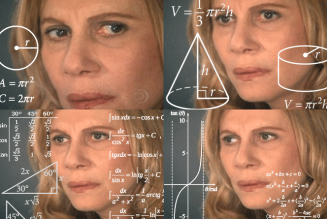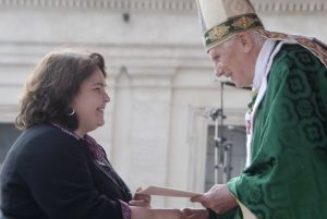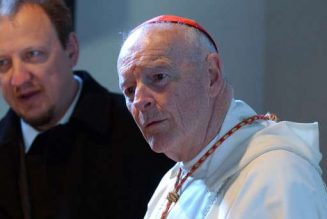Traduzione ufficiale in lingua inglese
Testo in lingua italiana
LETTERA APOSTOLICA
IN FORMA DI MOTU «PROPRIO»
DEL SOMMO PONTEFICE
FRANCESCO
«TRADITIONIS CUSTODES»
SULL’USO DELLA LITURGIA ROMANA ANTERIORE ALLA RIFORMA DEL 1970
Custodi della tradizione, i vescovi, in comunione con il vescovo di Roma, costituiscono il visibile principio e fondamento di unità nelle loro Chiese particolari.[1] Sotto la guida dello Spirito Santo, mediante l’annuncio del Vangelo e per mezzo della celebrazione della Eucaristia, essi reggono le Chiese particolari, loro affidate.[2]
Per promuovere la concordia e l’unità della Chiesa, con paterna sollecitudine verso coloro che in alcune regioni aderirono alle forme liturgiche antecedenti alla riforma voluta dal Concilio Vaticano II, i miei Venerati Predecessori, san Giovanni Paolo II e Benedetto XVI, hanno concesso e regolato la facoltà di utilizzare il Messale Romano edito da san Giovanni XXIII nell’anno 1962.[3] In questo modo hanno inteso «facilitare la comunione ecclesiale a quei cattolici che si sentono vincolati ad alcune precedenti forme liturgiche» e non ad altri.[4]
Nel solco dell’iniziativa del mio Venerato Predecessore Benedetto XVI di invitare i vescovi a una verifica dell’applicazione del Motu Proprio Summorum Pontificum, a tre anni dalla sua pubblicazione, la Congregazione per la Dottrina della Fede ha svolto una capillare consultazione dei vescovi nel 2020, i cui risultati sono stati ponderatamente considerati alla luce dell’esperienza maturata in questi anni.
Ora, considerati gli auspici formulati dall’episcopato e ascoltato il parere della Congregazione per la Dottrina della Fede, desidero, con questa Lettera Apostolica, proseguire ancor più nella costante ricerca della comunione ecclesiale. Perciò, ho ritenuto opportuno stabilire quanto segue:
Art. 1. I libri liturgici promulgati dai santi Pontefici Paolo VI e Giovanni Paolo II, in conformità ai decreti del Concilio Vaticano II, sono l’unica espressione della lex orandi del Rito Romano.
Art. 2. Al vescovo diocesano, quale moderatore, promotore e custode di tutta la vita liturgica nella Chiesa particolare a lui affidata,[5] spetta regolare le celebrazioni liturgiche nella propria diocesi.[6] Pertanto, è sua esclusiva competenza autorizzare l’uso del Missale Romanum del 1962 nella diocesi, seguendo gli orientamenti dalla Sede Apostolica.
Art. 3. Il vescovo, nelle diocesi in cui finora vi è la presenza di uno o più gruppi che celebrano secondo il Messale antecedente alla riforma del 1970:
§ 1. accerti che tali gruppi non escludano la validità e la legittimità della riforma liturgica, dei dettati del Concilio Vaticano II e del Magistero dei Sommi Pontefici;
§ 2. indichi, uno o più luoghi dove i fedeli aderenti a questi gruppi possano radunarsi per la celebrazione eucaristica (non però nelle chiese parrocchiali e senza erigere nuove parrocchie personali);
§ 3. stabilisca nel luogo indicato i giorni in cui sono consentite le celebrazioni eucaristiche con l’uso del Messale Romano promulgato da san Giovanni XXIII nel 1962.[7] In queste celebrazioni le letture siano proclamate in lingua vernacola, usando le traduzioni della sacra Scrittura per l’uso liturgico, approvate dalle rispettive Conferenze Episcopali;
§ 4. nomini, un sacerdote che, come delegato del vescovo, sia incaricato delle celebrazioni e della cura pastorale di tali gruppi di fedeli. Il sacerdote sia idoneo a tale incarico, sia competente in ordine all’utilizzo del Missale Romanum antecedente alla riforma del 1970, abbia una conoscenza della lingua latina tale che gli consenta di comprendere pienamente le rubriche e i testi liturgici, sia animato da una viva carità pastorale, e da un senso di comunione ecclesiale. È infatti necessario che il sacerdote incaricato abbia a cuore non solo la dignitosa celebrazione della liturgia, ma la cura pastorale e spirituale dei fedeli.
§ 5. proceda, nelle parrocchie personali canonicamente erette a beneficio di questi fedeli, a una congrua verifica in ordine alla effettiva utilità per la crescita spirituale, e valuti se mantenerle o meno.
§ 6. avrà cura di non autorizzare la costituzione di nuovi gruppi.
Art. 4. I presbiteri ordinati dopo la pubblicazione del presente Motu proprio, che intendono celebrare con il Missale Romanum del 1962, devono inoltrare formale richiesta al Vescovo diocesano il quale prima di concedere l’autorizzazione consulterà la Sede Apostolica.
Art. 5. I presbiteri i quali già celebrano secondo il Missale Romanum del 1962, richiederanno al Vescovo diocesano l’autorizzazione per continuare ad avvalersi della facoltà.
Art. 6. Gli Istituti di vita consacrata e le Società di vita apostolica, a suo tempo eretti dalla Pontificia Commissione Ecclesia Dei passano sotto la competenza della Congregazione per gli Istituti di Vita Consacrata e le Società di Vita Apostolica.
Art. 7. La Congregazione per il Culto Divino e la Disciplina dei Sacramenti e la Congregazione per gli Istituti di Vita Consacrata e le Società di Vita Apostolica, per le materie di loro competenza, eserciteranno l’autorità della Santa Sede, vigilando sull’osservanza di queste disposizioni.
Art. 8. Le norme, istruzioni, concessioni e consuetudini precedenti, che risultino non conformi con quanto disposto dal presente Motu Proprio, sono abrogate.
Tutto ciò che ho deliberato con questa Lettera apostolica in forma di Motu Proprio, ordino che sia osservato in tutte le sue parti, nonostante qualsiasi cosa contraria, anche se degna di particolare menzione, e stabilisco che venga promulgata mediante pubblicazione sul quotidiano “L’Osservatore Romano”, entrando subito in vigore e, successivamente, venga pubblicato nel Commentario ufficiale della Santa Sede, Acta Apostolicae Sedis.
Dato a Roma, presso San Giovanni Laterano, il 16 luglio 2021 Memoria liturgica di Nostra Signora del Monte Carmelo, nono del Nostro Pontificato
FRANCESCO
____________________
[1] Cfr. CONC. ECUM. VAT. II, Cost. dogm. sulla Chiesa “Lumen Gentium”, 21 novembre 1964, n. 23: AAS 57 (1965) 27.
[2] Cfr. CONC. ECUM. VAT. II, Cost. dogm. Sulla Chiesa “Lumen Gentium”, 21 novembre 1964, n. 27: AAS 57 (1965) 32; CONC. ECUM. VAT. II, Decr. sulla missione pastorale dei Vescovi nella Chiesa “Christus Dominus”, 28 ottobre 1965, n. 11: AAS 58 (1966) 677-678; Catechismo della Chiesa Cattolica, n. 833.
[3] Cfr. GIOVANNI PAOLO II, Litt. Ap. Motu proprio datae “Ecclesia Dei”, 2 luglio 1988: AAS 80 (1998) 1495-1498; BENEDETTO XVI, Litt. Ap. Motu proprio datae “Summorum Pontificum”, 7 luglio 2007: AAS 99 (2007) 777-781; Litt. Ap. Motu proprio datae “Ecclesiae unitatem”, 2 luglio 2009: AAS 101 (2009) 710-711.
[4] GIOVANNI PAOLO II, Litt. Ap. Motu proprio datae “Ecclesia Dei”, 2 luglio 1988, n. 5: AAS 80 (1988) 1498.
[5] Cfr. CONC. ECUM. VAT. II, Cost. sulla sacra liturgia “Sacrosanctum Concilium”, 4 dicembre 1963, n. 41: AAS 56 (1964) 111; Caeremoniale Episcoporum, n. 9; CONGREGAZIONE PER IL CULTO DIVINO E LA DISCIPLINA DEI SACRAMENTI, Istr. su alcune cose che si devono osservare ed evitare circa la Santissima Eucaristia “Redemptionis Sacramentum”, 25 marzo 2004, nn. 19-25: AAS 96 (2004) 555-557.
[6] Cfr. CIC, can. 375, § 1; can. 392.
[7] Cfr. CONGREGAZIONE PER LA DOTTRINA DELLA FEDE, Decreto “Quo magis” circa l’approvazione di sette nuovi prefazi per la forma straordinaria del Rito Romano, 22 febbraio 2020, e Decreto “Cum sanctissima” circa la celebrazione liturgica in onore dei santi nella forma straordinaria del Rito Romano, 22 febbraio 2020: L’Osservatore Romano, 26 marzo 2020, p. 6.
[01014-IT.01] [Testo originale: Italiano]
Traduzione ufficiale in lingua inglese
APOSTOLIC LETTER
ISSUED “MOTU PROPRIO”
BY THE SUPREME PONTIFF
FRANCIS
“TRADITIONIS CUSTODES”
ON THE USE OF THE ROMAN LITURGY PRIOR TO THE REFORM OF 1970
Guardians of the tradition, the bishops in communion with the Bishop of Rome constitute the visible principle and foundation of the unity of their particular Churches.[1] Under the guidance of the Holy Spirit, through the proclamation of the Gospel and by means of the celebration of the Eucharist, they govern the particular Churches entrusted to them.[2]
In order to promote the concord and unity of the Church, with paternal solicitude towards those who in any region adhere to liturgical forms antecedent to the reform willed by the Vatican Council II, my Venerable Predecessors, Saint John Paul II and Benedict XVI, granted and regulated the faculty to use the Roman Missal edited by John XXIII in 1962.[3] In this way they intended “to facilitate the ecclesial communion of those Catholics who feel attached to some earlier liturgical forms” and not to others.[4]
In line with the initiative of my Venerable Predecessor Benedict XVI to invite the bishops to assess the application of the Motu Proprio Summorum Pontificum three years after its publication, the Congregation for the Doctrine of the Faith carried out a detailed consultation of the bishops in 2020. The results have been carefully considered in the light of experience that has matured during these years.
At this time, having considered the wishes expressed by the episcopate and having heard the opinion of the Congregation for the Doctrine of the Faith, I now desire, with this Apostolic Letter, to press on ever more in the constant search for ecclesial communion. Therefore, I have considered it appropriate to establish the following:
Art. 1. The liturgical books promulgated by Saint Paul VI and Saint John Paul II, in conformity with the decrees of Vatican Council II, are the unique expression of the lex orandi of the Roman Rite.
Art. 2. It belongs to the diocesan bishop, as moderator, promoter, and guardian of the whole liturgical life of the particular Church entrusted to him,[5] to regulate the liturgical celebrations of his diocese.[6] Therefore, it is his exclusive competence to authorize the use of the 1962 Roman Missal in his diocese, according to the guidelines of the Apostolic See.
Art. 3. The bishop of the diocese in which until now there exist one or more groups that celebrate according to the Missal antecedent to the reform of 1970:
§ 1. is to determine that these groups do not deny the validity and the legitimacy of the liturgical reform, dictated by Vatican Council II and the Magisterium of the Supreme Pontiffs;
§ 2. is to designate one or more locations where the faithful adherents of these groups may gather for the eucharistic celebration (not however in the parochial churches and without the erection of new personal parishes);
§ 3. to establish at the designated locations the days on which eucharistic celebrations are permitted using the Roman Missal promulgated by Saint John XXIII in 1962.[7] In these celebrations the readings are proclaimed in the vernacular language, using translations of the Sacred Scripture approved for liturgical use by the respective Episcopal Conferences;
§ 4. to appoint a priest who, as delegate of the bishop, is entrusted with these celebrations and with the pastoral care of these groups of the faithful. This priest should be suited for this responsibility, skilled in the use of the Missale Romanum antecedent to the reform of 1970, possess a knowledge of the Latin language sufficient for a thorough comprehension of the rubrics and liturgical texts, and be animated by a lively pastoral charity and by a sense of ecclesial communion. This priest should have at heart not only the correct celebration of the liturgy, but also the pastoral and spiritual care of the faithful;
§ 5. to proceed suitably to verify that the parishes canonically erected for the benefit of these faithful are effective for their spiritual growth, and to determine whether or not to retain them;
§ 6. to take care not to authorize the establishment of new groups.
Art. 4. Priests ordained after the publication of the present Motu Proprio, who wish to celebrate using the Missale Romanum of 1962, should submit a formal request to the diocesan Bishop who shall consult the Apostolic See before granting this authorization.
Art. 5. Priests who already celebrate according to the Missale Romanum of 1962 should request from the diocesan Bishop the authorization to continue to enjoy this faculty.
Art. 6. Institutes of consecrated life and Societies of apostolic life, erected by the Pontifical Commission Ecclesia Dei, fall under the competence of the Congregation for Institutes of Consecrated Life and Societies for Apostolic Life.
Art. 7. The Congregation for Divine Worship and the Discipline of the Sacraments and the Congregation for Institutes of Consecrated Life and Societies of Apostolic Life, for matters of their particular competence, exercise the authority of the Holy See with respect to the observance of these provisions.
Art. 8. Previous norms, instructions, permissions, and customs that do not conform to the provisions of the present Motu Proprio are abrogated.
Everything that I have declared in this Apostolic Letter in the form of Motu Proprio, I order to be observed in all its parts, anything else to the contrary notwithstanding, even if worthy of particular mention, and I establish that it be promulgated by way of publication in “L’Osservatore Romano”, entering immediately in force and, subsequently, that it be published in the official Commentary of the Holy See, Acta Apostolicae Sedis.
Given at Rome, at Saint John Lateran, on 16 July 2021, the liturgical Memorial of Our Lady of Mount Carmel, in the ninth year of Our Pontificate.
FRANCIS
________________________
[1] Cfr Second Vatican Ecumenical Council, Dogmatic Constitution on the Church “Lumen Gentium”, 21 november 1964, n. 23 AAS 57 (1965) 27.
[2] Cfr Second Vatican Ecumenical Council, Dogmatic Constitution on the Church “Lumen Gentium”, 21 november 1964, n. 27: AAS 57 (1965) 32; Second Vatican Ecumenical Council, Decree concerning the pastoral office of bishops in the Church “Christus Dominus”, 28 october 1965, n. 11: AAS 58 (1966) 677-678; Catechism of the Catholic Church, n. 833.
[3] Cfr John Paul II, Apostolic Letter given Motu proprio “Ecclesia Dei”, 2 july 1988: AAS 80 (1988) 1495-1498; Benedict XVI, Apostolic Letter given Motu proprio “Summorum Pontificum”, 7 july 2007: AAS 99 (2007) 777-781; Apostolic Letter given Motu proprio “Ecclesiae unitatem”, 2 july 2009: AAS 101 (2009) 710-711.
[4] John Paul II, Apostolic Letter given Motu proprio “Ecclesia Dei”, 2 july 1988, n. 5: AAS 80 (1988) 1498.
[5] Cfr Second Vatican Ecumenical Council, Costitution on the sacred liturgy “Sacrosanctum Concilium”, 4 december 1963, n. 41: AAS 56 (1964) 111; Caeremoniale Episcoporum, n. 9; Congregation for Divine Worship and the Discipline of the Sacrament, Instruction on certain matters to be observed or to be avoided regarding the Most Holy Eucharist “Redemptionis Sacramentum”, 25 march 2004, nn. 19-25: AAS 96 (2004) 555-557.
[6] Cfr CIC, can. 375, § 1; can. 392.
[7] Cfr Congregation for the Doctrine of the Faith, Decree “Quo magis” approving seven Eucharistic Prefaces for the forma extraordinaria of the Roman Rite, 22 february 2020, and Decree “Cum sanctissima” on the liturgical celebration in honour of Saints in the forma extraordinaria of the Roman Rite, 22 february 2020: L’Osservatore Romano, 26 march 2020, p. 6.
[01014-EN.01] [Original text: Italian]
Join Our Telegram Group : Salvation & Prosperity








